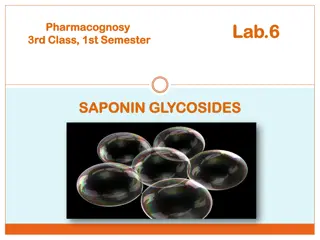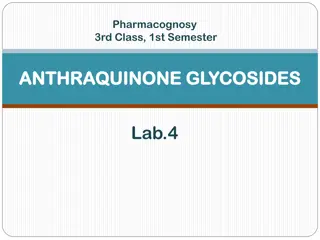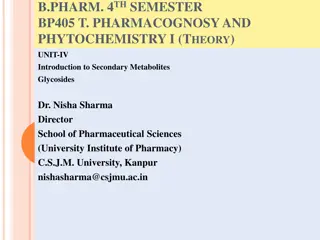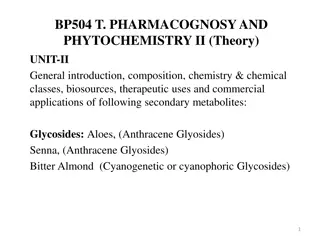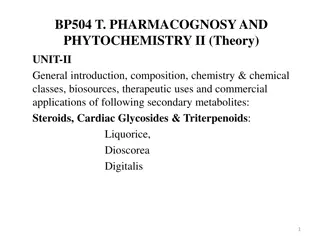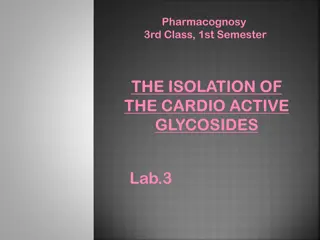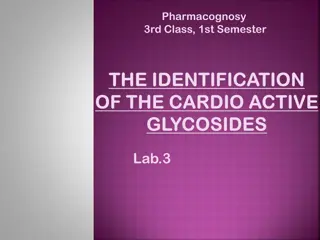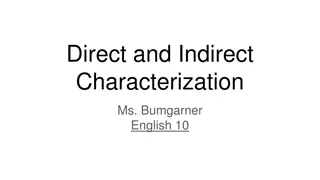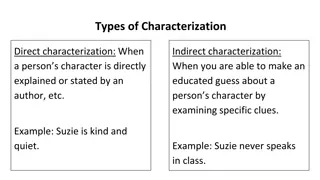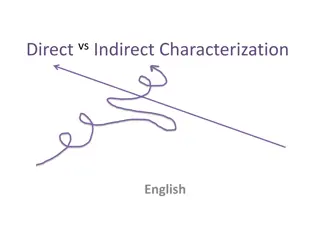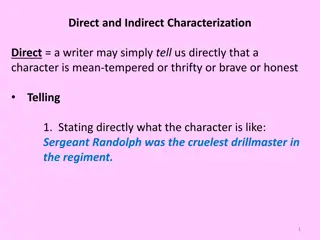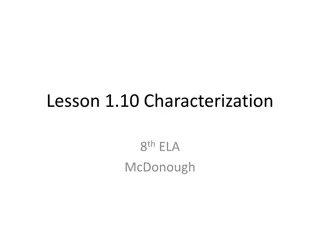Isolation and Characterization of Glycosides: Glycyrrhetinic acid and Rutin
This study focuses on the isolation and analysis of phytoconstituents, mainly glycosides such as Glycyrrhetinic acid and Rutin. It explains the methods for extracting glycosides, purification techniques, and characterization using spectroscopy methods. The detailed procedures for isolating Glycyrrhetinic acid from Glycyrrhiza roots are also outlined.
Download Presentation

Please find below an Image/Link to download the presentation.
The content on the website is provided AS IS for your information and personal use only. It may not be sold, licensed, or shared on other websites without obtaining consent from the author.If you encounter any issues during the download, it is possible that the publisher has removed the file from their server.
You are allowed to download the files provided on this website for personal or commercial use, subject to the condition that they are used lawfully. All files are the property of their respective owners.
The content on the website is provided AS IS for your information and personal use only. It may not be sold, licensed, or shared on other websites without obtaining consent from the author.
E N D
Presentation Transcript
B.PHARM. 5thSEMESTER BP504 T. PHARMACOGNOSY AND PHYTOCHEMISTRY II (Theory) UNIT-III Isolation, Identification and Analysis of Phytoconstituents B. Glycosides:- Glycyrhetinic acid, Rutin Dr. Nisha Sharma Associate Professor University Institute of Pharmacy C.S.J.M. University, Kanpur nishasharma@csjmu.ac.in 1
Glycosides Isolation of Glycoside :The method by which glycoside are isolated is called Sta-Otto method. Extraction: Finely powdered (drug containing glycoside) is extracted by successive extraction in a soxhlet apparatus with alcohol as solvent (Various enzyme deactivated due to heating). The thermolabile glycoside should be extracted at below 45 C. The extract is treated with lead acetate to precipitate tannins (eliminate non glycosidal impurities) and filtered it. To the filtrate H2S gas is passed, the excess of lead acetate is precipitate as lead sulphide. The extract is again filtered and concentrated to get crude glycoside. 2
Glycosides Isolation: The filtrate is subjected to fractional crystallization, distillation or chromatography to obtained pure component. Characterization: Pure component is determined by the spectroscopy method i.e. UV, IR, NMR, MS, etc. 3
Glycyrrhetinic acid Pentacyclic triterpenoid aglycone 4
Glycyrrhetinic acid Biological source: Glycyrrhetinic acid is a triterpenoid saponin glycoside obtained from the roots and stolons of Glycyrrhiza glabra belongs to family- Leguminosae. The chief constituent of liquorice is Glycyrrhizin (K & Ca salt of Glycyrrhizinic acid, a glucoside) which on hydrolysis yields Glycyrrhetinic acid (Glycyrrhetic acid). Isolation: The isolation of glycyrrhizin from Glycyrrhiza is based on its solubility. 5
Glycyrrhetinic acid Method 1: Required quantity of coarse powder of Glycyrrhiza roots is extracted with boiling water, filtered and concentrate the extract to obtain a crude liquorice extract. Then this extract is again extracted in water and acidified with HCl to maintain pH 3-3.4 to precipitate Glycyrrhetinic acid and filter. The residue is washed with water to yield Glycyrrhetinic acid . 6
Glycyrrhetinic acid Method 2: Transfer 20g powedered liquorice +50ml acetone +2 ml di. HNO3 , mix, macerate for 2hrs with stirring. Filter, transfer the marc to stoppered conical flask & add 20 ml acetone & filter Combine both filtrate, conc. under vacuum, Add dil NH3 sol. For ppt of NH4+ glycyrrhizinate Separate ppt by filtration and wash it with 5ml acetone (2x) followed by drying & weigh the product 7
Glycyrrhetinic acid Method 3: Weigh accurate qty of liqurice powder + CHCl3 in soxhlet apparatus for 3hrs. Filter the content of flask & discard the filtrate. The residue left on filter paper is then extracted with 0.5M H2SO4 for few hrs. Filter the content of flask. Transfer the filtrate in and extract with CHCl3 Separate & combine the CHCl3 layer. The combined CHCl3 layer is evaporated to dryness to get glycyrhetinic acid 8
Glycyrrhetinic acid Properties: Appearance : White crystalline powder Odor : Characteristic Taste : Characteristic Solubility : In soluble in water\ but freely soluble in alcohol, chloroform, benzene, ether etc. 9
Glycyrrhetinic acid Identification by chemical test: Libermann test: 3ml of extract and 3ml of acetic anhydride is heated and cooled. To this a drops of conc. H2SO4 is added. Blue colour is observed which indicate the presence of triterpenoid. Libermann-Burchard test: In 3ml of extract, 2ml of chloroform, 1ml of acetic anhydride and one drop of conc. H2SO4 is added. Blue- green to red orange color is observed which indicate the presence of triterpenoid or steroids 10
Glycyrrhetinic acid Estimation Reflux about 25 g of liqurice root powder+ 250ml water for 6hrs + NH3 to adjust pH 6.5-7, keep aside for few hrs. Centrifuge extract & evaporate to 75% of original vol. Add H2SO4 with stirring Decant supernatent liq. & suspend the ppt in 25ml H2O & adjust the pH 4 by Na2CO3 & stir about 2-3 hr & then centrifuge Again suspend the residue in H2O, pH 6, followed by centrifugation, drying in oven. Calculate % on basis of air dried drug calculated as glycyrrhetinic acid. 11
Glycyrrhetinic acid Analysis by TLC Sample preparation : 1mg of Glycyrrhetinic acid is dissolved in 1ml of methanol:Chloroform (1:1) Standard sample : Glycyrrhetinic acid Stationary phase : Silica gel G Mobile phase : Toluene: Ethyl acetate: Glacial acetic acid (12.5:7.5:0.5) Detecting agent : 1% vanillin-sulphuric acid reagent or Anisaldehyde-sulphuric acid and heated for 10minutes at 110C RF Value : 0.41 Colour spot : Purplish spot UV Blue fluorescence under at 365 nm. 12
Glycyrrhetinic acid Analysis by colorimetric method In the sample anisaldehyde and sulphuric acid is added, which shows purple color. The intensity of color is measured in colorimeter at 556nm. Utilization: It is used in Rheumatoid Arthritis, Inflammation and Addisions disease, ulcer, expectorants Storage condition: It should be store in well closed and air-tight containers protected from light and in cool place. 13
Rutin Fagopyrum esculentum (Buck wheat) Biological source: Rutin is a flavonoids glycosides obtained from the powered of dried food grains of Fagopyrum esculentum belongs to family- Polygonaceae. It is also obtained from various citrus fruit 14
Isolation: Rutin Required quantity of Fagopyrum powder is defatted with n-hexane and filtered. Then the marc is extracted with 78% of alcohol for 1 hour, filtered it and evaporated to obtain dried residue. Residue is dissolved in sufficient quantity of 30% acetone, filtered and evaporated the solvent to th of its original volume. Sufficient quantity of 5% aqueous solution of borax is added (until resulting pH is 7.5) with continuous stirring. Sufficient quantity of solid NaCl is added with stirring. Mixture is filtered and acidify with phosphoric acid to bring pH to 5.5 and stirred for 15minutes. Then the mixture is filtered and residue is washed with 20% NaCl solution. Again mixture is filtered and evaporated the filtrate to 500 C to th of its original volume. HCl is added to the mixture in hot condition to bring pH to 1.5, cooled and kept in a refrigerator overnight. Crystal of rutin is separate out 15
Rutin Properties: Appearance : Greenish yellow powder Odor : Odorless Solubility : Sparingly soluble in water but its solubility increase in boiling water soluble in methyl alcohol, isopropyl alcohol, pyridine and solution of alkali hydroxides Identification by chemical test Shinoda test: 3ml of ethanol and few drops of sulphuric acid are added to the sample. To this 0.5g of magnesium turnings is added. Pink colour is developed which indicate the presence of flavonoids. Lead acetate is added to the sample. Yellow coloured precipitate is observed which indicate the presence of flavonoids. Ferric chloride is added to the sample. Dark green colour is observed which indicate the presence of flavonoids Taste : Tasteless 16
Rutin Analysis by TLC Sample preparation : 1mg of Rutin is dissolved 1ml of methanol Standard sample : Rutin Stationary phase : Silica gel G Mobile phase : Ethyl acetate: butanone: formic acid: water (50:30:10:10), Ethyl acetate: butanone: formic acid: water (100:10:11:27) Detecting agent : Anisaldehyde sulphuric acid reagent RF Value: 0.43 (10% aqueous sodium chloride solution) Color spot : Yellow spot 17
Rutin Utilization: It is used to treat capillary bleeding along with increased capillary fragility and thereby useful in treatment of retinal haemorrhages. It is also used as Antioxidant. Storage condition: It should be store in well closed and air-tight containers protected from light and in cool place. 18
References Lecture notes by Mr. Ashutosh Meher, Associate professor, Barpali, Bargarh, Odisha 19



